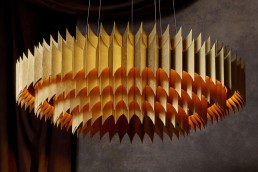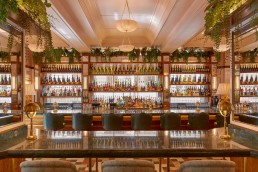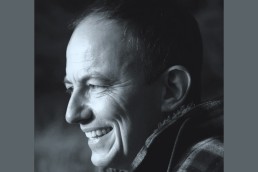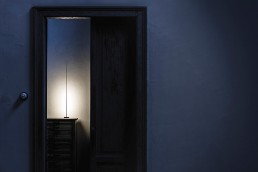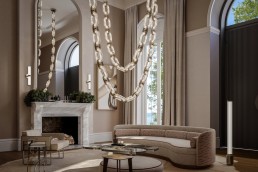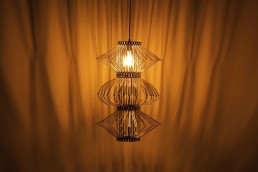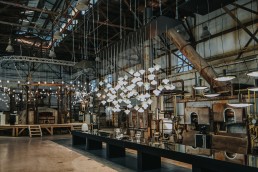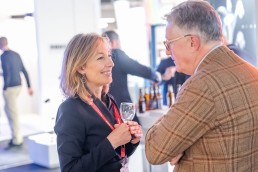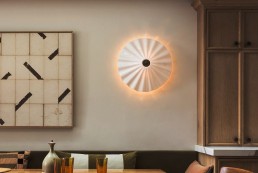London Design Festival Review
darc’s Junior Journalist, Ellie Walton, reviews her week of exploring what the light industry had to offer at London Design Festival (LDF).
LDF returned for another September to celebrate the UK’s capital as well as the city’s central design hub. Sadly, the event’s exhibition London Design Fair didn’t make a comeback for the 2024 edition. Nevertheless, the event wasn’t short of things to see and once again drew in some of the country’s greatest designers, retailers and artists for a celebration of design. The lighting community came to the forefront with showroom openings, exhibitions and the latest products that are making waves in the market.
Starting our week off with an evening party, our first showroom drop off was at Lee Broom in Shoreditch. On arrival, we were greeted with a glass of champagne and a glorious cheese board, - I had learned the hard way from last year to not get to the party late or else the cheese will be gone! This party was dedicated to Broom’s London launch of the award-winning collection, Alchemist. The King Chandelier hung in all its glory displaying tapered multiple tiered rings, while illuminated the light envelopes the golden spikes, casting shadows and light. In addition, the Mythos collection was also on display with its wall sconce taking a proud position next the Broom’s iconic swing chair.
The following day took us to Westminster for the Ligne Roset showroom party, where an evening of cocktails accompanied the debut of its revised collection from Pierre Guariche, an iconic figure in French design. Guariche’s collection seamlessly coexists with Ligne Roset’s models, with the standout piece being the G30 floor lamp. Known as the “kite lamp”, Guariche named it for its sail-like shade made of white perforated metal, held by two brass wires, evoking the image of a boat’s sail caught in the wind. True to Guariche’s minimalist style, the lamp is as much a striking ornament as it is a functional piece of lighting.
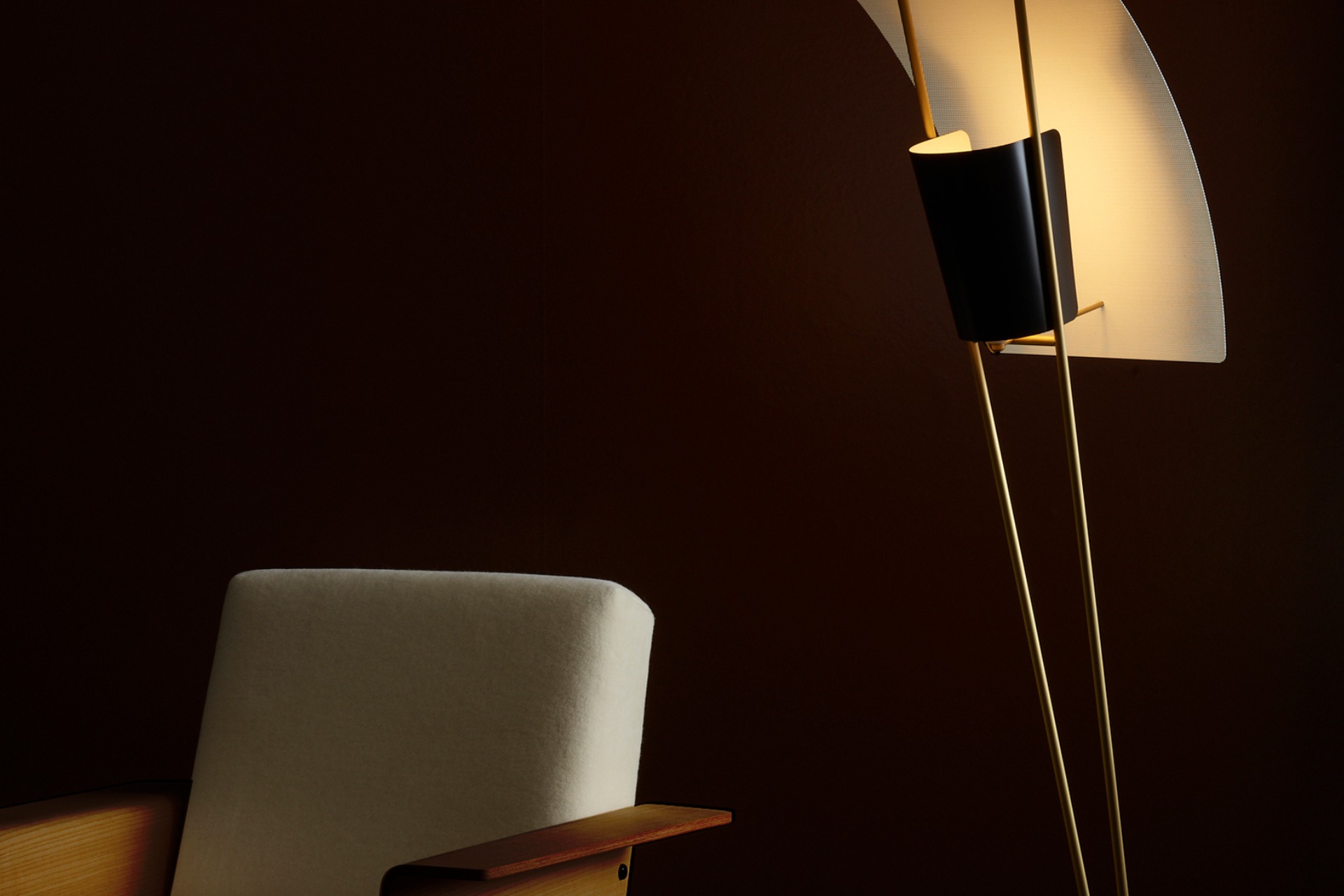
Speaking of nostalgic pieces, we visited Joe Armitage, a London-based product designer known for his contemporary designs and creations for brands such as Tala, released his own revised lighting collection of his grandfather’s floor lamp. Showcasing at the SCP in Shoreditch, the Armitage lamp collection, completed in 2021, is Armitage’s contemporary twist on his grandfather’s elegant concept, showcasing an iconic conical shade and consists of a floor lamp, desk lamp, wall lamp, accent lamp and two suspension lamps. Armitage also debuted new additions to his Modernist collection, which first made waves with his Modernist desk lamp, taking design inspirations from contemporary jazz, dance music and modernist architecture. The design of the shade emerged from a form-finding process that explores the unique properties of recycled PET parchment. The flexible material arches between two straight supports, securing its position - this method results in a distinctive U-shaped shade that features throughout the collection. The latest editions showcased at LDF included a linear pendant lamp and wall lamp.
darc couldn’t make a visit to London without seeing Occhio, a brand known for its decadent showroom parties as well as lighting known for its minimalist elegance and technology. The South Kensington showroom had a recent refurbishment, adopting its ethos of “Culture of Light”, the idea of allowing people to design their own light in their living spaces. The lower level of the building has been transformed into an apartment style showroom, with a kitchen, dining and living space where clients can experience how Occhio lighting can transform their homes. Customers can try products such as the Luna and discover its Fireball light technology and how it’s atmospheric settings can conduct a space.
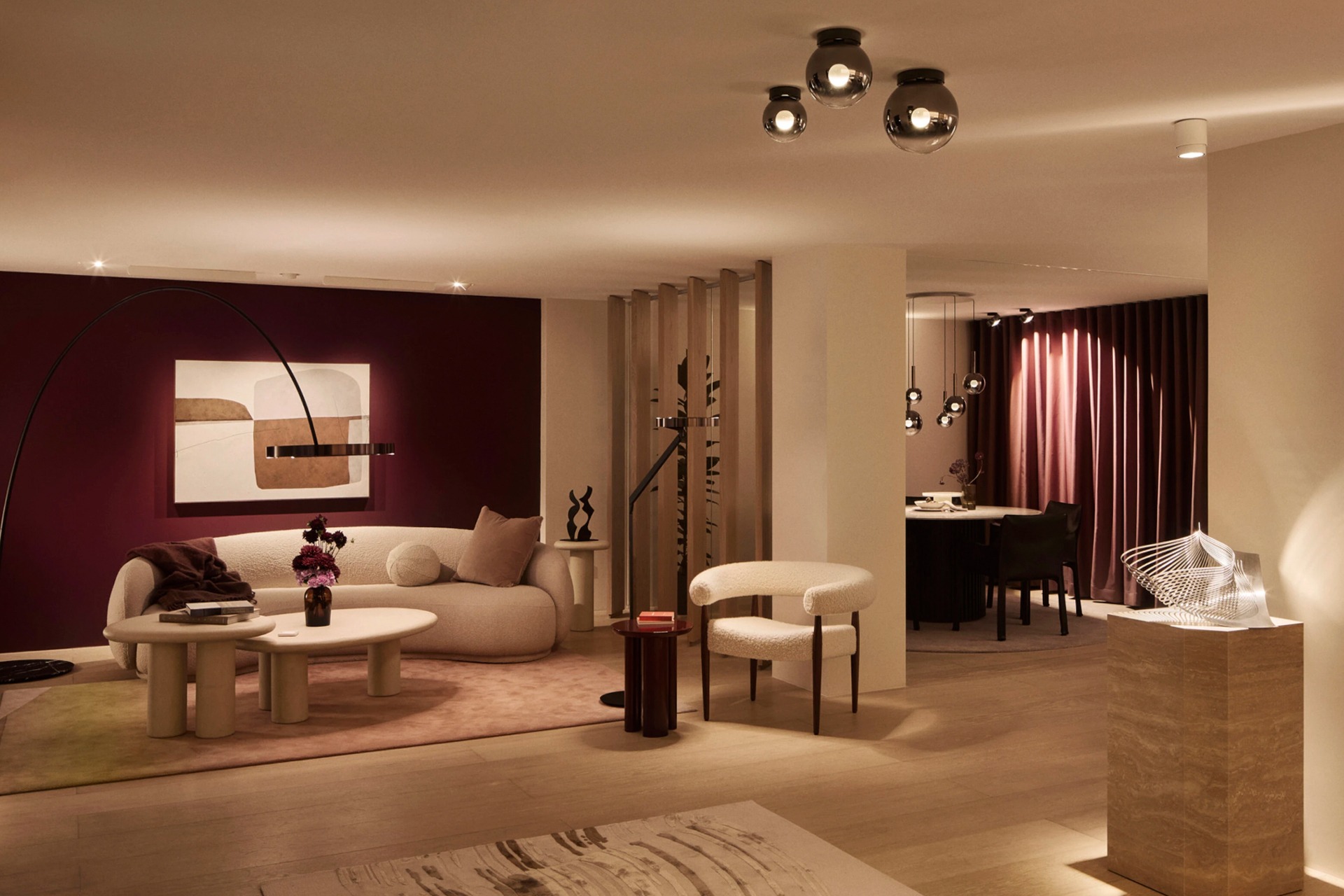
LDF wasn't just for big brands; it showcased a vibrant mix of creatives and artists. Sustainability was at the heart of the event, with the Material Matters exhibition spotlighting innovative materials like seaweed, grass root, and contact lens cases. Returning to the Bargehouse at OXO Tower Wharf, it explored how these materials shape our world. A highlight was seeing the return of Mushlume, a New York-based lighting brand that grows lampshades from mycelium. This year, the brand unveiled two new wall sconces: the Outward Journey and Inward Journey. Elsewhere in the exhibition, Hydro, a Norwegian aluminium company, also collaborated with designers like Max Lamb to create the first industrial-scale aluminium lamps from post-consumer scrap.
As well as products, London Design Festival offers a whole host of design inspiration from installations and art exhibitions. The "Light in Motion" exhibition, presented by Acrylicize, explores light's transformative power, celebrating its fluid relationship with space, movement, and time. Showcasing in Bethnal Green’s The Art House, it features works from 12 artists and engineers. Curated by Sean Malikides and Jessie Temple, the exhibition showcases light as a sculptural form, evolving over time to reshape environments and challenge viewers to engage with light spatiality. Exhibits like Duncan Carter’s "10,000 Tiny Suns", Sophie Mei Birkin’s "Biomatter Submersion", and Will Laslett’s "Falling Light" used light in innovative ways to evoke natural phenomena like time or material transformation. The work of light artist James Turrell was heavily mirrored throughout the exhibition, aiming to project his idea that light is not just a tool of revelation but a revelation itself.
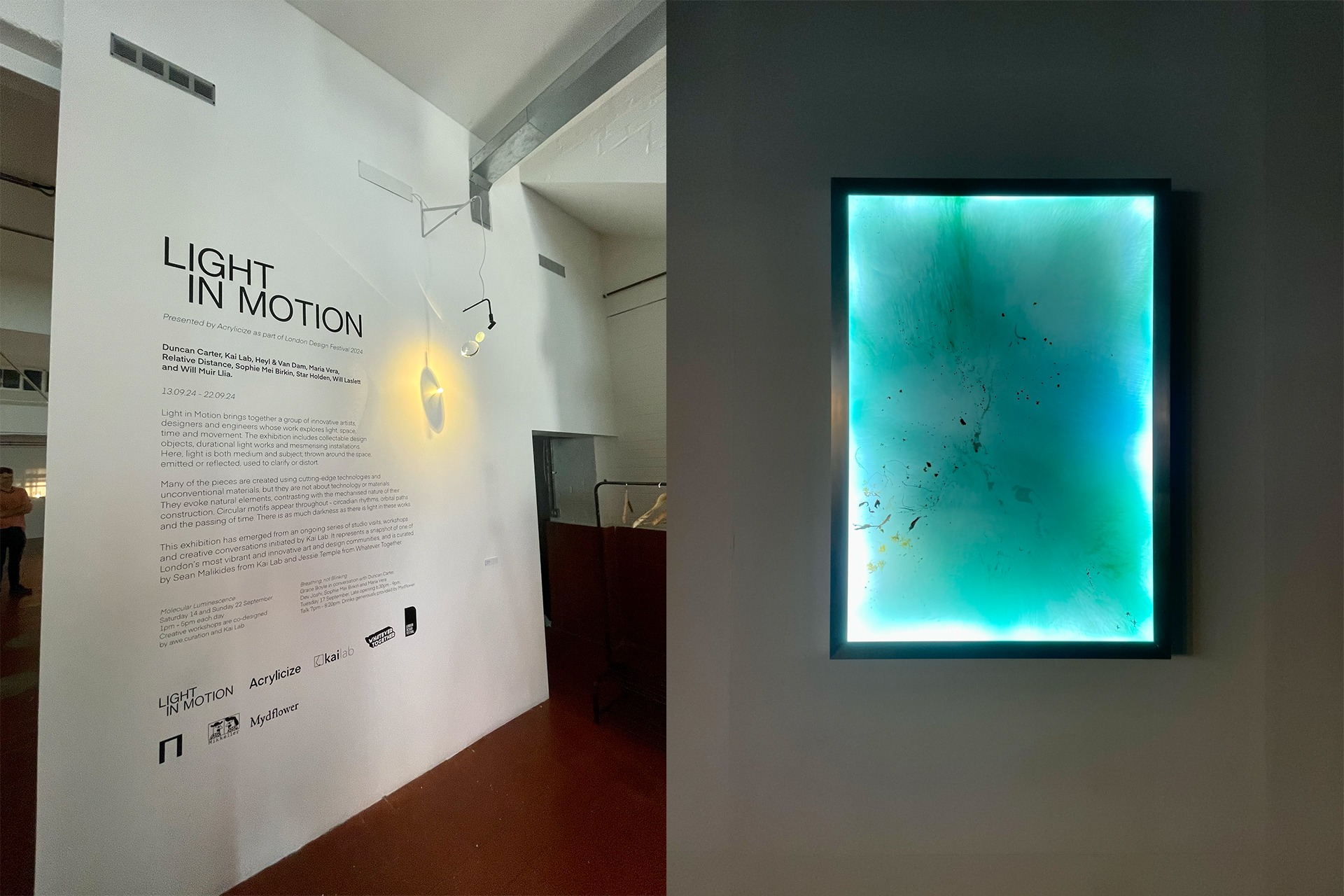
Overall, the 2024 London Design Festival successfully showcased the diverse and innovative spirit of the UK's design community, despite the absence of its traditional fair. From showroom events to thought-provoking exhibitions, the week-long celebration drew attention to cutting-edge designs and emerging trends. As always, darc remains eager to see what new advancements the lighting industry will bring to the next edition in 2025.
San Carlo - Fettle
Fettle brings a new atmosphere to the already well-respected San Carlo restaurant in Liverpool, UK, utilising layered light with beautiful decorative fixtures.
In the heart of the UK’s northern city, Liverpool is the iconic San Carlo restaurant, which has recently undergone a stunning renovation by London and LA-based interior and architecture studio, Fettle.
Fettle’s brief for the project was to refresh and reinvigorate the existing, well-established space, an all-day dining restaurant, which offers an opulent and contemporary take on traditional Italian dining with elegant interiors inspired by Grand Milanese villas and gardens. Fettle also drew from the architecture of Piero Portaluppi, creating a space that has an alluring ambience and timeless sophistication.
Speaking with darc on their involvement in the project is Andy Goodwin, Co-Founder and Creative Director at Fettle. “San Carlo was an existing client of ours and we had already successfully worked with the company on two London restaurants. San Carlo Liverpool was an existing site in their portfolio that they wanted to completely renovate and re-design. Having previously worked with the San Carlo brand, we were excited to embark on this new, large scale refurbishment project. Our brief was to reimagine the space including the bar, restaurant, private dining room and wine room. We stripped back the existing space to a shell, completely renovating and re-designing each element of the building.
“Altogether, the project took 14 months to complete.”
The design studio employed a rich and dramatic palette of marble, high gloss, timber and brass detailing throughout the venue. These are softened by layered mohair, leather and patterned fabric upholstery.
The furniture has been designed specifically for the project, including marble and timber tables, fluted oak bar stools with brass bases and green leather seats, elegant curved legged dining chairs and burnt orange leather and velvet banquette seating.
According to Goodwin, the project brief remained consistent throughout, with minor developments only occurring when the team discovered more about the site following its strip-out, and they were able to add a wine room to the basement corridor as requested by San Carlo.
The biggest challenge Fettle overcame was simply the process of re-designing an already successful site. Goodwin elaborates: “Our job was to retain the spirit of the existing space while totally reviewing and revising the aesthetic.”
When it came to lighting the space, Fettle introduced an array of decorative fixtures in colours and tones that beautifully blend with the overall design.
“Decorative lighting was a key component of the scheme and worked cohesively with other elements of the design to create a sophisticated ambience and timeless space,” explains Goodwin.
“We used a mixture of high-level chandeliers and pendant fittings to give an overall softness, as well as a range of wall lights and table lamps to give a more focused glow to each area of the bar and restaurant.
“Key pieces of the design have also been highlighted with concealed recessed LED lighting such as the back bar, planting and wine displays.
“We used a combination of bespoke and off the shelf lighting for the project. Bespoke Murano chandeliers were made in Italy by Sogni Di Cristallo, and these sit alongside a range of Visual Comfort wall and table lamps.
“We also used lights by Pure White Lines, Lion Iron Lighting, Northern Lights, Neoz, Humber, and bespoke lampshades by Yately Papers.
“Overall, we used a wide variety of types of lighting throughout each space, enabling us to dim everything down to create a comfortable and intimate atmosphere. We try to add as many layers of lighting as possible in order to give us and the client maximum flexibility in terms of light levels and dimming.
“Lighting is always a vital part of the design and helps inform the overall atmosphere of the space.
In San Carlo Liverpool’s case, it creates an elegant, intimate and playful ambience, working seamlessly with the interior design as a whole.
“The lighting scheme is broadly residential and layered in its approach. Architectural lighting was typically used to highlight details in joinery such as bars / back bars and planters, as well as providing more functional lighting over waiter stations and within coffers.
“By using a mixture of pendants, wall lights and table lights we were then able to create atmosphere by keeping these fittings dimmed to a low level throughout.
“Lighting is always a vital part of the design and in San Carlo Liverpool’s case, it creates an elegant, intimate and playful ambience, working seamlessly with the interior design as a whole.”
Lighting designers from engineering consultancy Hoare Lea were brought onto the project to collaborate with Fettle due the client’s specific requests to have balanced light throughout the venue. “This isn’t something we would typically do on a restaurant scale project and is normally reserved for larger hotel projects,” says Goodwin. “However, the client team were very keen for the light levels to be absolutely right, and that compatibility was ensured between the high number of different fittings, the lamps and the overall dimming system.”
Ben Acton, Associate at Hoare Lea tells darc about his participation in achieving these desires from the client: “We had previously collaborated with Fettle Design on a hotel project that was highly successful. Following that, Fettle recommended us to the San Carlo team, believing we could contribute significant value to their project. Fettle’s strong understanding of the importance of lighting played a key role in our collaboration. Our task was to work alongside Fettle to develop a lighting scheme that seamlessly complemented their decorative lighting choices with architectural lighting, resulting in a harmonious overall design. Coordination was crucial to ensure that each lighting element was discreetly integrated into the interior.
“Communication is the most important aspect to a successful project, and we have an excellent working relationship with Fettle. Initially we reviewed their design concepts, then, with multiple workshops together, we developed a detailed lighting scheme that offers layers of lighting that complemented their beautiful interior.
“Designing a restaurant that functions equally well during the day and night is a significant challenge. The goal is to ensure the space feels bright and inviting during the day while creating a warm and intimate atmosphere in the evening. Achieving this required a careful selection of luminaires and a sophisticated lighting control system. Since evenings are the restaurant’s busiest time, this was our primary focus. Our key approach to fostering intimacy was to create pools of light on the dining tables, allowing the surrounding areas to remain relatively dark. This effect was complemented by soft background illumination and the use of very warm, 2200K lighting along the perimeter, achieving the ambiance the client desired.
“To maintain the restaurant’s appeal during the day, we needed to provide relatively high lighting levels. While the restaurant benefits from ample daylight along one elevation, the deeper areas towards the rear risked feeling gloomy by comparison. To enhance the overall ambiance, large decorative globe pendants were used to deliver the necessary lighting, ensuring the space remained vibrant and inviting throughout the day.”
Due to the nature of the project, Acton goes on to explain the challenges they faced when tackling an already existing space: “This often presents unexpected challenges, especially when you start opening ceilings and seeing what you have to work with. In some areas, finding suitable locations to conceal drivers was challenging. However, by utilising custom joinery and strategically placed access panels, we were able to accomplish this discreetly and effectively.”
He continues, describing the various decorative lighting layers and how they worked alongside the architectural lighting: “The decorative lighting within the restaurant is a big part of its identity, complementing the interior design with a wide selection of chandeliers, pendants, wall lights and table lights working in combination. These elements add a lot of sparkle and contrast that add to the overall ambiance and character and identity of the spaces. Battery powered table lights are also positioned to all tables, which provide functional illumination, but all importantly provide focused accent light throughout the restaurant.”
Reflecting on the completed project, Goodwin explains how their designed remained consistent with the team’s initial plans: “We approach every project with a detailed design narrative and each space is unique. Stand out features for this project include the oversized, contemporary murals by artist Jesslyn Brooks, statement chandeliers, and the rich and dramatic palette of marble, high gloss, timber and brass detailing, softened by layered mohair, leather and patterned fabric upholstery.
“We wanted to develop a clear identity for the restaurant while retaining an aesthetic commonality with San Carlo’s sister restaurants. We feel we have created a truly elegant space with design details, lighting and material finishes utilised to offer a sophisticated yet relaxed dining experience.”
Acton adds: “I’m extremely pleased with the final lighting scheme and how the layering of different elements creates a flexible and adaptable space. The way the lighting interacts with the mirrors throughout the restaurant adds a sense of dynamism, offering new and intriguing perspectives as you move through the space. I’m particularly delighted with the bar backlighting, which makes a stunning first impression as you enter the restaurant and creates an eye-catching display visible from the street.
“The client for this project places a strong emphasis on lighting and has a deeper understanding of its importance than most I’ve worked with. This was especially evident during the commissioning of the lighting scenes, where he was very hands-on as we collaborated to create an ambiance that perfectly complemented the dining experience. It was incredibly rewarding to work with a client who truly appreciates the intricate details of a successful lighting scheme.
“The decorative and joinery-integrated lighting is a very warm 2200K, which effectively creates mood and intimacy throughout the space. The few downlights we’ve used are at 2700K, which works well for highlighting artwork, especially during daytime dining. However, in the evening, the contrast between these lighting elements becomes more noticeable. To achieve greater cohesion, I would like to have explored the possibility of using filters to warm up the downlights.”
Simon Mayhew: Celebrating one year of TXTURED
darc's Junior Journalist, Ellie Walton, recently sat down with Simon Mayhew, interior designer and founder of Manchester-based studio Txtured to celebrate the one-year anniversary of his creative venture. Early this summer, Txtured marked the milestone by officially opening its physical studio space in Manchester. In this interview, Mayhew shares his personal journey into the world of interior design, the challenges of launching his own studio, and the pivotal role that lighting plays in Txtured’s design philosophy.
Originally hailing from the quaint town of Felixstowe in East Suffolk, Mayhew had a love for the arts and a sense of creativity for his whole life. In his late teens he moved to London where he pursued a successful career as a dancer, gracing the stages of the West End, the Royal Opera House, and touring globally with renowned groups like the Osmonds and the 12 Tenors. During his time as a dancer in London, his passion for interior design grew to become a constant interest that was quietly nurtured alongside his other pursuits.
“I’ve always loved interiors.” says Mayhew, “Between the ages of 18 and 21, while I was in dance college I had a retail job in the perfume department at Harrods that I would do in between auditioning for roles. What I loved about Harrod's was the interiors, - the marble, the lighting, the Egyptian escalators, everything was very inspiring.”
After his career as a dancer Mayhew shifted gears, venturing into the business side by establishing a successful theatre agency, which continues to thrive today. It was during this time Mayhew became a Soho House member, whose inimitable aesthetic and uses of textures became the final catalyst for Mayhew’s design dreams. After 13 years of running the agency, Mayhew decided to take the plunge into the design world.
“When I became a Soho House member, my obsession for interiors eventually overtook my love for what I was doing at the time. I exhausted everything I could do within the theatre industry and my love for interior just became increasingly overcoming.”
Mayhew describes himself as “a bit of an anomaly,” in the sense that he never took the stereotypical route in his career paths. At 18, he opted for stage school over university, diving into show business as an agent without formal training — relying solely on his drive and passion for the industry. His approach to entering interior design followed a similar pattern. Rather than pursuing a traditional university degree, Mayhew took online courses and immersed himself in personal research and talking to other seasoned designers.
Jumping from the performing arts realm to interior design may seem like a radical career change to some people; however, Mayhew found that his previous career provided him with the skills and knowledge that set the company up for success. In addition to the business skills he gathered, Mayhew also referenced how his performing experience prepared him for the presentation side of being an interior designer. "You've got to have confidence," he explains. "Being a performer, although it has its downfalls such as a lot of self-criticisms, also provided me with the confidence to really put myself out there.”

When starting Txtured, Mayhew’s vision was to create an interiors studio that captured all five senses, integrating a blend of materials, colours, and scents. The inspiration for the studio’s name harks back to his time in London’s Soho House; Mayhew was particularly drawn to Soho House's masterful use of fabrics, admiring how the layering and variation of materials create depth, warmth, and evoke emotion in a space. However, when it comes to style, Mayhew has a real sense of direction on how his studio focuses on residential, commercial or hospitality with timeless designs to create one off spaces that feed the imagination. “I want to be versatile,” says Mayhew. “I don't want to get put into box of being just a high-end, Mid-Century, Modern, and so on.”
His foray into interior design was not the only change in his life. After the COVID-19 pandemic Mayhew and his partner decided to start a new life in the North’s unofficial capital, Manchester. The decision was made after seeing promising residential projects, so they purchased their first property in the Castle Wharf Apartments. Despite leaving the hustle and bustle of London, Mayhew's design ambitions remained undeterred, proving that opportunities extend beyond the capital. Embracing life in the North with open arms, Mayhew is determined to invigorate the region's design scene with his unique vision and creativity.
“I believe that I bring something different to Manchester’s design scene. I would like to see Manchester be a bit braver and step out of its comfort zone because there is a lot of repetition and looking back on the past instead of setting an example for the future,” says Mayhew. “A great example of that is Fenix [a Mediterranean restaurant in Spinningfields, Manchester] it is so unique to other places in the city, and I hope to see it make an impact on projects up here, whether it be residential or commercial. I also want to try and make something that really stands out and is unique. However, the thought behind the Fenix design is to last a long time in a timeless sort of way, which is also what I am hoping to achieve.”
The first year of Txtured has faced both challenges and triumphs, which is typical for any new business. Despite the hurdles, it has been a remarkable year for the studio, with projects spanning the country. A notable project included a conversion of a three-story townhouse in Islington, London. The client specifically sought out Txtured for its distinct design philosophy and aesthetic sensibilities. Reflecting on the project, Mayhew shares: “My favourite part of the project was in the living room, which has a glass mezzanine where you can peer into the lounge. We are creating an office space on the mezzanine and then installing this gorgeous lighting fixture, which will run from the mezzanine into the living room with these gorgeous double height ceiling fabric curtains. This is my first full renovation, so a big milestone for the studio. however, I have some exciting project potentially on the horizon.”

Mayhew’s sense of style and taste is immediately apparent; his presentation and energy alone inspire confidence in his ability to craft chic interiors. As an interior designer whose philosophies centre around sensory experience, lighting is therefore taken into careful consideration. He sees decorative lighting as more than accessories and believes it can conduct a room’s personality and the people within it.
“Lighting significantly impacts how you feel,” tells Mayhew. “An example of how I look at it in a project is from my own living room. I had a gorgeous light that was freestanding, it looked aesthetically gorgeous and was dimmable. However, it didn't dim low enough. I had it for about a year and every time I sat on the sofa, I felt disturbed and agitated and therefore I couldn’t feel relaxed. The reality was the light was far too bright. So, I changed it to another lamp but instead focused on the type of lighting it would bring. This transformed the whole feeling of the space in the evening.”
Mayhew appreciates even the subtle nuances of light and design, noting the significant impact that something as simple as a dimmer switch can have on a space. He acknowledges how slight changes in lighting can dramatically alter a room's atmosphere. Among his favorite brands to work with are North-West-based Tyson Lighting and J. Adam & Co., whose blend of classic and modern styles serves as a major inspiration for Txtured.
Mayhew adds: “I'm always think about lighting, and how it differs for every project. If you are in a grand entrance hall and there's loads of natural light and loads of natural space, then you need to embrace what you have already got. If you are in an office environment or a boardroom, for example, or a living space, you want to bring a light that will channel a calmer atmosphere. Sometimes, I see lighting that is too bright and therefore I will add a dimmer or shadows. Alternatively, in some places, like Dubai for example, they will make lighting a statement piece. It totally depends on the space.”
Sustainability is also a key consideration in the studio’s lighting choices, reflecting a growing trend among designers to prioritise responsible design. During a recent trip to Clerkenwell Design Week, Mayhew was particularly inspired by the range of upcycled products, highlighting Spark & Bell's wall and pendant lights made from recycled CD cases. He hopes to incorporate similar sustainable ideas into larger hospitality projects in the future.
Before this interview Mayhew had just returned from a trip to Dubai with his partner as a celebration for the studio’s 1-year anniversary and Mayhew’s birthday. Mayhew says that travelling is one of the ways he seeks out new inspiration for his design. During the interview Mayhew pulls out a beautiful, large stone lamp with both Arabic inspired styles on the base and a Grecian-style lamp shade.
“This is inspired by Dubai and by Mykonos. I like the idea of taking design elements from various places because lighting in Dubai, in Mykonos, or in Marrakesh, are all going to be quite different and can be incorporated in a cool way. So, travel is a huge inspiration for me.
“Magazines are also a huge source of inspiration. I like social media, but I would much rather sit down with a coffee and a magazine, because it is less overstimulating” he explains.
Despite Mayhew’s preference to detox from social media for work time inspiration, he first started as an influencer account for amateur interior design called My Home in the City. Mayhew explained the Instagram account started purely as a fun way of documenting their new home’s transformation while experimenting with social media. However, this creative side project grew more demanding in time and content as the page grew in popularity. Today, the account is now the social media home of Txtured and Mayhew admits he has taken a backseat from influencing life while he completes projects and runs the company.
“I just haven’t had time. Although, I'm currently working on a marketing strategy for the next 12 months. I want to try and do more content now I have my studio space where I will have a little content corner. I had an idea to do product focuses such as on lighting products or different paints. I have to say social media is a big commitment and is not an easy task; the algorithm can really ware people down because it is challenging to overcome.”
It's fair to say Txtured has come a long way for a first-year studio; from humble beginnings as an influencer account to a full-time interior designer with his own studio and successful projects all across the country. Mayhew is one to pick the road less travelled, from successful theatre agent to interior designer, he has proven that taking a U-turn in life is worth the risk if it is something you are willing to work hard at. After the official opening of his own studio space in Manchester, he has ambitions to expand the team and the brand’s horizons – it will be exciting to see where Txtured will be in another year's time. When reflecting on his journey so far Mayhew finished with one piece of advice, he would have given himself at the start of his journey. He says: “Things are not going to happen quickly, so just be patient, which is a quality I lack. My advice to anyone would be you just have to do it and take the plunge. It takes time, but don’t give up. Keep building those connections, learn from your mistakes, and keep going because, despite what social media tells you, things don’t happen overnight.”
Irene Mazzei on responsible design
In addition to Hollingsbee’s Lighting Guide, Mazzei discusses what to look for when specifying products for a sustainable criteria, and expands on additional assesments to be aware of.
Specifying truly sustainable products is not as easy as it seems. The market is full of green labels and images of leaves stamped on products, often used to cover unsustainable practices – in other words, greenwashing.
It is important that specifiers look for clues and evidence of real sustainable efforts from companies, such as verification from respected agencies and assessment results reported using common metrics. Ideally everybody should be using the same metrics to assess environmental impacts, so it is important to follow advice from industry organisations on the best actions to take and methodology options to adopt.
We are currently seeing manufacturers investing efforts into publishing environmental impact information at product level, in different ways:
- Using CIBSE TM66, to assess a product’s circular economy performance
- Using CIBSE TM65, to estimate a product’s embodied carbon
- Using Life Cycle Assessment to create Environmental Product Declarations, for a comprehensive range of impacts.
- CIBSE TM65 and TM66 are industry-led assessment methods which have been developed to help companies assess and report environmental aspects of products – embodied carbon and circular economy performance, respectively.
TM66 was developed specifically for the lighting industry and is based on a detailed questionnaire investigating characteristics such as repairability, easy disassembly, availability of spare parts and information for luminaires. Evidence of these and several other features are also required to be able to assign a circularity score to a product – from 0 to 4 – to categorise its circularity from low to excellent. Being able to easily evaluate luminaires this way allows to assess whether products on the market are able to support the development of a circular economy in the lighting industry, and it also helps manufacturers understand which aspects of their products they can change to achieve a higher circularity score for their luminaires.
TM65’s embodied carbon assessment method was initially developed for the wider MEP (mechanical, electrical and public health) sector, however in 2023 an update was published that contained lighting-specific information: TM65.2. The objective of TM65 is to give manufacturers a way to estimate the embodied carbon of their products in the absence of an Environmental Product Declaration (EPD). TM65’s assessment method was created to be easily understandable and applicable by any manufacturer, as it is an accessible and straightforward calculation methodology based on some assumptions and simplifications and not as granular as a full Life Cycle Assessment (LCA). For this reason, although an alignment can be observed, often the results of the TM65 calculations are not as accurate as the results of a full LCA, due to the trade-off between accuracy and simplicity of the approach. The TM65.2 lighting update is able to capture some aspects of products that were overlooked in the original version, and contribute to achieve more accurate results.
Life Cycle Assessment is a robust and globally recognised environmental assessment methodology, regulated by specific standards. For commercial communications, it is often preferred to report LCA results as third-party verified declarations, such as EPDs. These documents are published by organisations called Programme Operators, which, in addition to the standard rules of LCA, can develop Product Category Rules (PCRs) and Product Specific Rules (PSRs). These are useful to be able to adapt LCA to a type of product with specific characteristics, such as luminaires. It is important that the rules developed by different Programme Operators are aligned: this is why LightingEurope decided to endorse the PSR0014 by PEP Ecopassport as the most comprehensive set of rules for lighting products.
What is important for specifiers is to be careful when comparing impacts when they were obtained using different methodologies; this is why getting familiar with the different types of assessment schemes and methodologies available is now becoming crucial in the industry.
Companies can also communicate their efforts to be more sustainable through company-level assessment schemes, for example looking at Scope 1, 2 and 3 emissions and Net Zero ambitions, or focused on the wider meaning of sustainability – including also social and economic wellbeing – through schemes like B Corp or EcoVadis. The B Corp badge is the result of an assessment measuring a company’s performance against features that ensure inclusive, equitable and regenerative development, also supported by the company’s transparency and commitment. Similarly, EcoVadis is a platform that provides sustainability rating for businesses, looking at environment, labour and human rights, ethics and sustainable procurement, plus a dedicated section for carbon emissions.
Independently on the type of environmental assessment a company chooses to adopt, it is pivotal that the results are communicated transparently to the public. This is the only way we can truly support sustainability and empower people to make the right choices.
Dave Hollingsbee on responsible design
Hollingsbee provides a breakdown of various certifications and accreditations that aim to guide manufacturers and designers to create and specify responsible products.
1. B lab
Used by: Patagonia, Ben and Jerry’s, Stoane Lighting, Anglepoise
B Lab is the not-for-profit organisation set up to measure a company’s entire social and environmental impact. B Corp Certification is a designation that a business is meeting high standards of verified performance, accountability, and transparency on factors from employee benefits and charitable giving to supply chain practices and input materials. In order to achieve certification, a company must:
- Demonstrate high social and environmental performance by achieving a B Impact Assessment score of 80 or above and passing their risk review. Multinational corporations must also meet baseline requirement standards.
- Make a legal commitment by changing their corporate governance structure to be accountable to all stakeholders, not just shareholders, and achieve benefit corporation status if available in their jurisdiction.
- Exhibit transparency by allowing information about their performance measured against B Lab’s standards to be publicly available on their B Corp profile on B Lab’s website.
www.bcorporation.net
2. Eco Vadis
Used by: Ledvance, Signify, Zumtobel, Lucent
The EcoVadis platform helps you manage ESG risk and compliance, meet corporate sustainability goals, and drive impact at scale by guiding the sustainability performance improvement of your company and your value chain. By submitting to their EcoVadis assessment process, their assessors award medals dependent on the applicants scores relative to others on the EV database. eg. Platinum= top 1%, Gold = top 5% Silver = top 15% etc.
www.ecovadis.com
3. Declare
Used by: David Chipperfield Architects, Haworth Tomkins
Architects Declare is free to join. Many signatories use the simplicity and clarity of the shared declaration as a catalyst to drive effective change within their organisations. Many also use it as a tool to demonstrate their commitment to combatting the climate and biodiversity emergency in discussion with their clients and project partners.
www.uk.architectsdeclare.com
4. BREEAM
BREEAM is used to specify and measure the sustainability performance of buildings. Using this framework helps projects to meet their sustainability goals and achieve optimal performance over time. The BREEAM framework provides solutions to many of the key challenges facing the built environment, from working towards net zero carbon to addressing health and social impacts
www.breeam.com
5. LEED
Used by: The Empire State Building. Apple Park (aka “Campus 2]
LEED categories can contribute toward meeting the SDGs, not only by saving water, increasing energy efficiency, minimising of carbon emissions (GHGs) and significantly reducing harmful air pollutants, etc. but also by promoting education, creating jobs, improving health and wellbeing, enhancing community resilience, and much more. Policymakers, planners, and builders can use LEED and sustainable building practices as strategies for achieving the UN SDGs. There are many synergies between LEED and the SDGs. Explore the synergies between LEED and the SDGs on their website, to identify strategies to achieve specific SDGs through LEED certification.
www.usgbc.org
6. International Living Future Institute
The International Living Future Institute’s mission is to cultivate a society that is socially just, culturally rich, and ecologically restorative.
Its work is driven by a belief that a compelling vision for the future is needed to reconcile humanity’s relationship with the natural world. Of the many initiatives that come under ILFI’s umbrella, perhaps the most pertinent to this article is their “Declare” label. An easy-to-read ‘nutrition label’ for products with online resources to promote, share, and find healthier building materials.
Also, under the ILFI’s umbrella (see above) is the Red List. The Red List is a list of chemicals representing the “worst in class” substances prevalent in the building industry that pose serious risks to human health and the environment. The Red List is organised by chemical class and lists individual chemicals by Chemical Abstract Registry Number (CASRN). Since its inception in 2006, the Red List has been an intuitive tool for communicating the need to stop using chemicals that cause harm. Building projects (particularly in USA) may ask suppliers to provide assurances of their absence in their products or declare presence where that may apply.
www.living-future.org
7. Science based Targets
Used by: Whitecroft Lighting
Science-based targets provide a clearly defined pathway for companies to reduce greenhouse gas (GHG) emissions, helping prevent the worst impacts of climate change and future-proof business growth. Science-based targets provide companies with a clearly defined path to reduce emissions in line with the Paris Agreement goals. More than 5,000 businesses around the world are already working with the Science Based Targets initiative (SBTi).
www.sciencebasedtargets.org
Davide Groppi limited edition Anima
(Italy) - The Anima table lamp will be released with a limited 280 pieces to celebrate winning XXVIII Compasso d’Oro Award.
The jury of the awards describe the lamp as “the reduction of the thickness and the material used, which is combined with an idea of expressiveness capable of satisfying genuine requests for coming into contact with transcendental nature of public that us increasingly bombarded by trivialising messages.”
The special edition lamp comes with golden finished details and a certificate showcasing its unique serial number.
Cameron Design House - Koru
(UK) - Launching at Decorex in October, British lighting and furniture studio Cameron Design House is introducing Koru, the latest design from Creative Director and Founder, Ian Cameron.
Koru, meaning ‘jewel’ in Finnish, draws from Cameron’s Finnish heritage. Each chain link of the chandelier is hand-carved from white alabaster. The individual illumination of each link accentuates the translucent qualities and veins of the alabaster, while metal elements clasp the links together.
Ian Cameron comments: “The Koru chandelier represents a significant moment for us as it marks our first use of alabaster, a material that embodies both strength and delicacy. Our ambition was to create a piece that not only makes a bold aesthetic statement but also celebrates the organic beauty and unique qualities of alabaster, bringing something truly extraordinary to our collection.”
The piece will be on display at Decorex, hosted at Olympia Events, London from the 6 – 9 October.
www.camerondesignhouse.com
Ben Cantu returns to Luxxbox
(USA) - Luxxbox, global designer of lighting solutions, announce the return of Ben Cantu as VP of Business Development (Luxxbox/Panzeri) and Western Regional Sales Manager.
Cantu rejoins Luxxbox to lead the Western US sales growth, applying his knowledge of the architectural lighting industry to work with Luxxbox's extensive network of agents on creative projects.
During this time the company recently merged Italian lighting brand Panzeri and launched several new acoustic lighting pendants – Kurtain, Stalik, Sierra, and Illi Bon.
"I'm thrilled to be back at Luxxbox, a company that has always been at the forefront of innovative lighting design," says Cantu. "I'm excited to contribute to the continued growth of Luxxbox and Panzeri, collaborating with both brands’ innovative and high-quality lighting solutions in the North American market."
Jason Bird, Founder and Creative Director of Luxxbox, adds: "We're so excited to welcome Ben back into the Luxxbox family. He's a seasoned industry veteran with a proven track record of success. His deep understanding of the lighting market, combined with his ability to build strong relationships, will be invaluable as we continue to expand our business and introduce new and exciting products."
www.luxxbox.com
Istituto Marangoni London announces graduate exhibition
(UK) – Fashion and design school Istituto Marangoni London hosts its inaugural graduate exhibition at the Design Museum during London Design Festival.
Titled ‘Momentum: A design Narrative’, the exhibition brings together 12 BA and MA graduates across the fields of jewellery, interior, and visual design, showcasing creative solutions for modern society and forging new narrative within the industry.
Taking place 13-14 September at the mezzanine level at the Design Museum, the exhibition presents an opportunity for selected graduates to exhibit their works in one of the world’s leading design institutions and work alongside the museum’s curator and programming teams.
In the lead up to submitting final projects, the students received support from the school’s cohort of academics and industry experts, including London-based design agency, Pearson Lloyd, who were appointed as mentors for the 2023/2024 academic year. Students were encouraged to develop creative and innovative solutions while being mindful of designing with a positive and lasting impact on our environment and communities.
MA Product Design student, Yinghua Zha, will be showcasing their Yinghua Zhan a self-assembled modular light product designed with a focus on sustainability. Yinghua envisioned a 3-D folding shape with a modular pattern that can turn into a half-rhombus and half-circle simply by flipping cut stripes in different directions. The product is assembled from a single rectangular laser-cut recycled aluminium sheet, ensuring nearly zero material waste. The pendant works as a modular system; each piece can connect with others to form various structures.
Valerie Berdah-Levy, School Director of Istituto Marangoni London says: "We are thrilled to host our first graduate exhibition at the prestigious Design Museum ‘Momentum: A Design Narrative’, which marks a significant milestone for our graduates as they embark on their careers, allowing them to showcase their work in one of the world’s leading institutions devoted to design. Not only will this exhibition highlight the incredible talent amongst our graduates, but it also affirms our commitment to fostering innovation within the design community."
The exhibition will be free to attend? and will open to the public during London Design Festival 2024. For more information visit designmuseum.org/exhibitions/momentum-a-design-narrative
Inside Glassmakers by Brokis 2024
The Glassmakers Night by Brokis returned for its annual event held at Janštejn Glassworks in the Czech Republic town, Panské Dubenky.
The fifth edition of the event served retrospective to Milan Design Week 2024, providing an in-depth and intimate presentation of the products and extended collection that debuted in Milan this year.
The exclusive invite-only event welcomed visitors from around the world to attend a unique opportunity to witness how Brokis Glass and Brokis Lighting are created in the glass factory. Hand-blown glass features were made in person in front of guests during the day, followed by an evening drinks event topped with the unveiling of a top-secret installation.
darc’s Editor Sarah Cullen and Junior Journalist Ellie Walton had the pleasure to be invited to Telč along with other international, design-focused journalists to experience the event. Below, Walton recaps her time in the Czech town, experience of the full Brokis works, and interview with Jan Rabell, Founder of Brokis.
Glassmaking in the Czech Republic has a rich and extensive history. Traditionally, most of the glassworks were concentrated in the northern regions of the country, though others were spread throughout different areas. Over time, the quality of the molten glass and the resulting products achieved an exceptional standard, leading to global recognition of Czech glass. Janštejn Glassworks, known for hand-blown glass components used in Brokis lights, has a legacy spanning more than 200 years earning it the inclusion of handmade glass production on the UNESCO List of Intangible Cultural Heritage.
When Jan Rabell, entrepreneur, and Founder of Brokis, first bought Janštejn Glassworks in 1997, the industry was in decline with many glassmakers retiring and the rise of technology that could do the work at a quicker and much cheaper rate. Initially the investment was a speculative transaction with the hope of turning a profit once the price went up. However, after spending time learning about the craftmanship, Rabell saw a new vision, to restore the status of Bohemian hand-blown glass. Rabell says: “One of the first things I had to do was convince my wife of the potential of the glassworks and that we should move from Prague to be closer to Janštejn. In time, however, I fell in love with the art of glassmaking and began to see far greater potential and beauty in it. There was a need to support and cultivate a new tradition that would last for future generations, including my own children, which is why I’ve made them an active part of our journey. We are, after all, a family-run business.”
Rabell began the Glassmakers event five years ago during the Covid-19 pandemic when industry tradeshows and events were being closed, leaving the brand to find a new way to present its products to global markets. Rabell saw the opportunity to highlight what is at the heart of Brokislighting, its hometown and Janštejn Glassworks. Rabell says: “It was important for us to show where Brokis comes from and how unique the location is.”
The event commenced in the charming town of Telč, where we were treated to a delightful breakfast at a café and wine bar, which is owned by Brokis’ Deputy Director and Jan Rabell’s son, André Rabell. Afterward, we journeyed to the Brokis factory, where we were warmly welcomed by Mr. Rabell and a cup of rich espresso. The summer’s day was perfect for exploring the historic glassworks, which has lived in the corner of the Vysočina region since 1809. Walking around the premises, we could still see traces of its storied past, from towering chimneys to the original factory building, which are all centred around a large well of water that functions both for aesthetics but also for safety in case of fire.
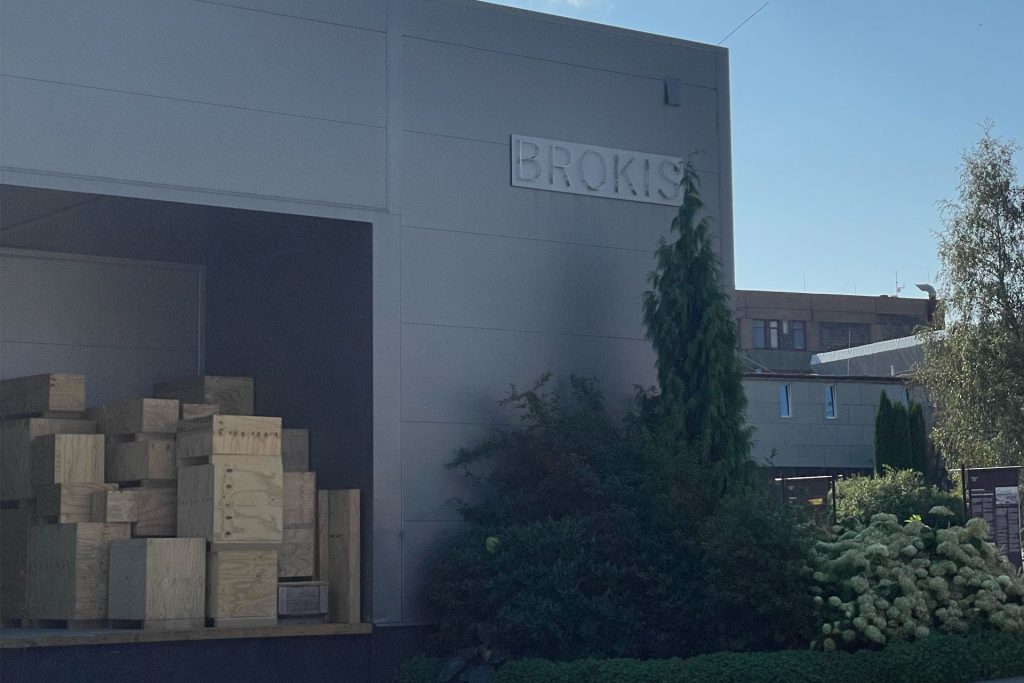
As we entered the expansive newer factory building, the sun’s warmth was soon replaced by the unforgiving heat emanating from the ovens and furnaces. The men and women working there were clearly masters of this craft, each one possessing a blend of confidence and patience to handle molten glass in a way that is so casual and effortless. Watching them manoeuvre metal poles topped with glowing liquid glass was both awe-inspiring and, in all honesty, a bit nerve-wracking too. It was hard not to feel on edge about being in the glassblower’s way, yet equally difficult to resist the urge to get closer and marvel at the fiery dance at the end of their flutes.
The glassblowers worked at their assigned stations where they carried out their part of the production line. We watched the first step where silica is mixed with sand to create colourful glass, which in Brokis’ repertoire are typically translucent, white, smoke brown, rose pink, and orange. When removed from the furnace, the glassblower then continuously spins the molten glass and uses a wooden cup and water to create a smooth surface before gently blowing and turning the hollow pole.
In Rabell’s quest to reinvoke tradition, Brokis avoid using any modern technology, robots, or machines to create their glass parts. However, his vision was to invigorate the industry, which required a more contemporary design. This is when he introduced Lucie Koldova as Designer and Creative Director at Brokis, who’s modern designs brought Brokis to the attention of international interior designers and design enthusiasts.
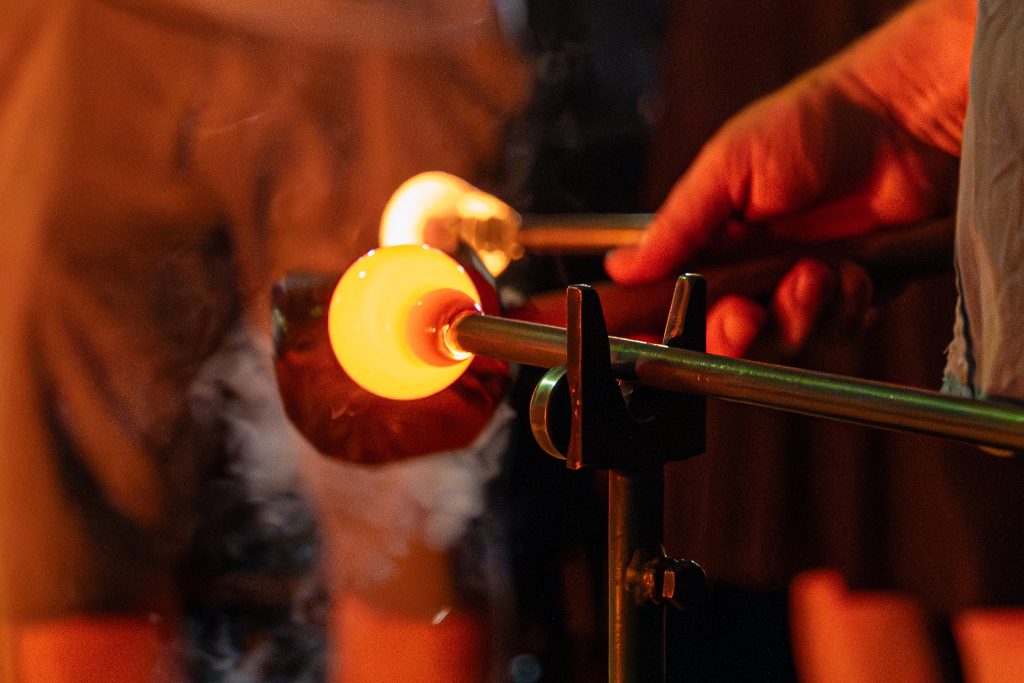
Koldova’s designs often makes unique and graphic shapes that have brought the brand’s glassblowing to whole new level to its predecessors. In one stage of our tour, we watched the creation of one of Koldova’s latest novelties, Spectra, which has an intricate shape that can only be done by one glassblower in the factory. The craftsman makes the piece in one go, blowing the molten glass to size, he then lowers it into a mould located in a pit below floor level of the factory where he continues to blow while a second person helps finalise the shape with compressed air and water. Once the desired shape is achieved, the final piece is put into a kiln to cool very slowly and set. Following the kilning process, items are polished, and quality control checked on a production line before moving to assembly and packaging.
Despite the ease in which the factory workers operate, there are many things that go wrong during the process, which was echoed in the small mountains of shattered glass that were situated outside the factory. However, Rabell showed us that not all is lost when mistakes happen. The team use the broken glass remnants to create furniture pieces such as tabletops, home accessories, or signage. The scraps are melted into sheets of fused, colourful glass that is then cut, washed, and polished into its final shape. This is what is known as Brokisglass.
Following our time on the factory floor, Koldova took over the tour to explain more about the design process. She has been with Brokis since 2013 and is the designer of two of the latest novelties launched this year: the Starcloud and the Spectra. Brokis avoid over saturating the market with seasonal designs and opt for the release of one collection per year with some extensions of best-selling collections, hence the annual celebration of the Glassmakers event. There are many reasons for this including sustainable production, giving each product or product extension the time and attention they need to be appreciated across an international market, and to respect the time that goes into making a Brokis light.
“We need to give space to the collections to make sure that each one gets the right space to penetrate the new markets,” explains Koldova. “Also, the lights must be prepared for all types of market because each is different. For example, the use of different cables and electrical certifications, and so forth can be hard to decipher. So, developing one collection takes a lot time and testing to get it to the right standard for all the markets, which costs a lot of money and effort. Therefore, perfecting one collection per year allows us to be ready for anything.”
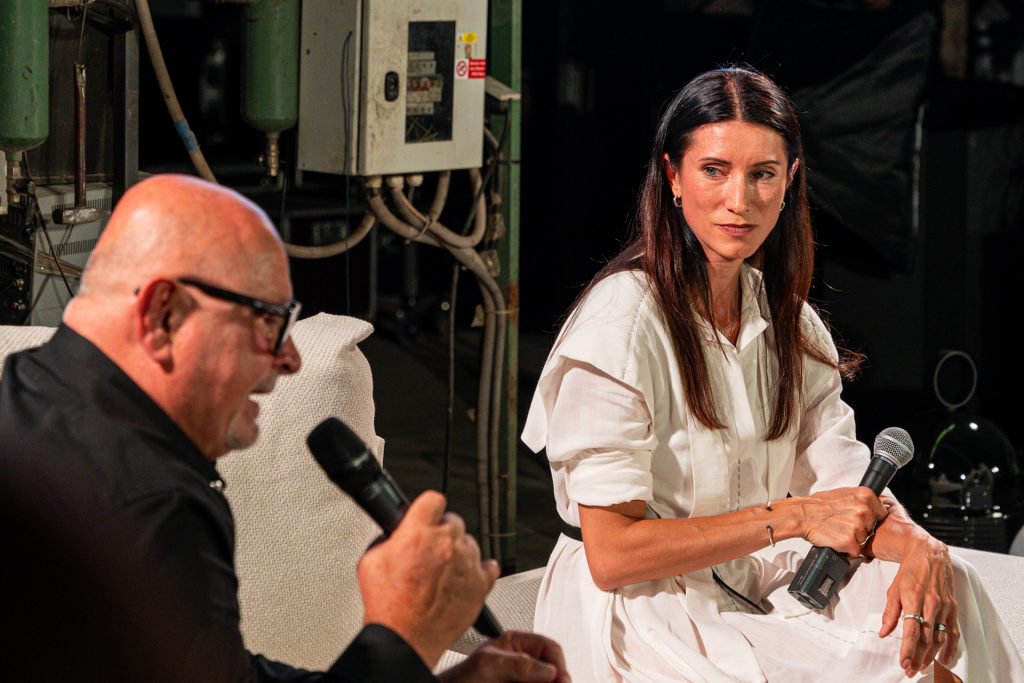
The tour then moved to a small press conference where Italian interior stylist Simona Sbordone and photographer Max Zambelli joined the group to discuss the recently launched Brokis Storyline catalogue. Featuring more than 120 lights from across the Brokis portfolio set in four extraordinary locations, the project marks the beginning of a new chapter in the presentation of the Brokis brand. The catalogue tells the story of a selection of magnificent homes and how the lights change and take on different identities depending on the time of day, all presented in a beautiful large-format printed publication.
In the evening, we returned to the factory for a glamorous night of cocktails, DJ set with a live saxophonist plus, the glassblowers performing their magic skills with opportunities to have dabble with glassblowing ourselves.
Later in the evening, all guests moved into the old factory house, which had been transformed into a showroom displaying new collections from Dome by LCM Marin design studio and Convex by designer Boris Klimek, and novelties from Lucie Koldova taking centre stage. During the unveiling, Koldova spoke about the detail and inspiration of each design. Speaking on her pendant collection ‘Starcloud’, she says: “From the offset, my aim was to design a collection that would let the user create grand constellations. There are three distinct shapes, which I named after three well-known stars: Atria, Lyra, and Vega. The rotational shapes gain in strength and then diminish again, waxing and waning like real stars and completing one another, yet at the same time they exist on their own. They form a shining cloud in the sky, with gentle gradient colours and fluid lines softening the intensity of these cosmically inspired objects.”
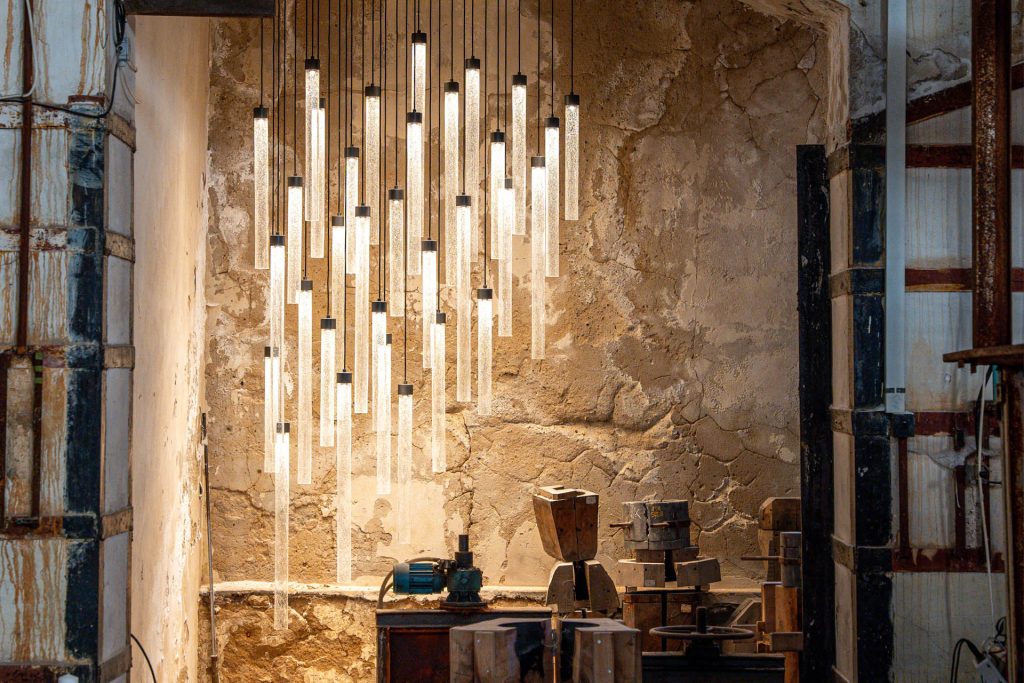
Her second piece, Spectra, (which we saw being made during the tour) is the result of her search to reinvent the archetypal lamp shape but keeping the classic silhouette of a lamp shade and base yet made from one pure piece of glass. Koldova explains: “I wanted to create an elementary, simple line, an external mantle that would serve as the base and the shade in one. The inverted outline of the mantle gives way to an opening in the centre, where I then positioned a two-way light source, the intensity of which can be easily adjusted. The shape of the mantle evokes a sense of levity and loftiness. A specialised method of glassblowing is required to create the mantle as a single piece. The overall appearance of the light emphasises the idea that beauty lies in simplicity.”
After the designers presented their pieces, there was a final unveiling from Rabell and Sbordone, her first collaboration with the brand, a concept piece titled ‘Comet’. The installation displayed an arrangement of approximately 30 tube-like pendants characterised by a distinctive textured glass suspended from different heights, which was created through a special technology of adding silica sand to the molten glass as the glass tubes are hand blown. Comet is another bold statement to the Brokis collection. In addition to the concept chandelier, Sbordine has created a range of home accessories using Brokisglass that were displayed beautifully on pedestals. This set the stage for Rabell’s final announcement of welcoming Sbordine as the new Creative Director of Brokisglass.
As the night drew to a close, we were gifted with a Brokisglass handblown espresso set, all made from the recycled shards of glass. On reflection, the Glassmaker’s Night is about more than celebrating the products and the designers but also a celebration of the glassmakers themselves. Rabell’s aim to revitalise the Czech glassblowing industry has also brought life into the community with many of the locals working for Brokis, acquiring a unique talent that few and far between can do around the world.
LiGHT 24 Welcomes All Designers
(UK) – The only trade show in the UK dedicated to lighting specification provides an incredible opportunity for designers to discover new technologies, solutions and inspiration.
Lighting is one of the first things that designers should consider when working on a project. The importance of working with the right tools and having the right knowledge to produce the best light – and in turn the best environment for the end user – is undeniable.
A common misconception is that trade shows dedicated to lighting specification are just for lighting specialists. Yet by bringing together architects, interior designers and lighting designers with innovative brands and suppliers, LiGHT 24 is the perfect opportunity to find the right lighting for your next project, whatever the role you play.
So, if you’re not a lighting designer, what does LiGHT 24 have to offer you?
If you are looking for ways to more seamlessly integrate the right lighting solutions into your project designs, you can learn more about the effects of lighting on design schemes and the end user. LiGHT 24 will feature 100s of high-end decorative and architectural lighting brands all under one roof. With brands from all over the world on show, it is guaranteed that there will be a product at LiGHT 24 that fits the brief for your next project.
A dedicated space for decorative and design-led lighting brands returns to the gallery level for a second year, focused on providing a space to collaborate, inspire and specify decorative, design-led lighting solutions all under one roof.
This year, the Associations Lounge will host a number of industry associations from the architecture, interior design, and lighting communities, providing a comfortable space for designers to meet with colleagues and gain vital information on the advantages of memberships with these associations.
Not only that, but the next [d]arc thoughts talks programme is taking place at LiGHT 24. This highly-regarded talks programme will feature experts from across the world of design and editors from speciality design magazines, while covering project highlights and topics that affect all areas of the industry. Watch this space for a full talks programme announcement coming very soon!
Are you ready to meet like-minded individuals and make connections in the lighting, interior design and architecture communities? LiGHT 24 offers visitors multiple unrivalled networking opportunities, including late-night welcome drinks during the first evening and the popular LiGHT LUNCH on day two of the event. This year, LiGHT LUNCH will be centred around a Women in Industry networking event - this brunch with representatives from Women in Lighting, Women Lighting Professionals, Women in Office Design, Women in Architecture, and the Women in Furniture Design Network, offers an in-person insightful opportunity to find out more about these empowering initiatives and how to get involved.
Another networking opportunity will be the Silhouette Awards event, which involves the entire global lighting community, featuring advice from the programme's mentors and mentees, education insights, presentations, discussions, and all-important photo opportunities.
LiGHT WORK will also make a welcome return to the show, with visitors making good use of the dedicated workspace area to network, hold meetings, or complete office tasks, while offering dedicated wi-fi, free coffee, and charging points so that you don’t need to leave the show floor to do vital work.
LiGHT Expo values bringing together inspiring leaders and passionate people to share ideas and solutions to grow the future of the industry. For all visitor information, visit: www.lightexpo.london
Don’t miss your chance to be part of this inspiring and influential event! Registration is now OPEN > LiGHT 2024
Original BTC - Christie Light
(UK) – The British lighting manufacturer is releasing a wall light version of its popular Christie light.
The new addition is hand slip-cast at the company’s Stoke-on-Trent factory, with a gently fluted shade that celebrates bone china’s versatility. Featuring the brand’s signature mix of materials, the 47cm shade is secured by solid brass fittings in an antique brass finish.
Charles Bowles, Original BTC Director, says: “From the rise and fall of ocean waves to the corrugation of washed-out shells, each ceramic fold echoes the movement and flow found in nature,” describes the brand. “Crisp white when off, when switched on, Christie emits a beautifully ambient glow, casting light through the shade and hypnotic shadow onto the wall behind. One of our most decorative, large scale wall lights yet, Christie will soften the clean lines of contemporary spaces while blending beautifully with more traditional schemes.”

